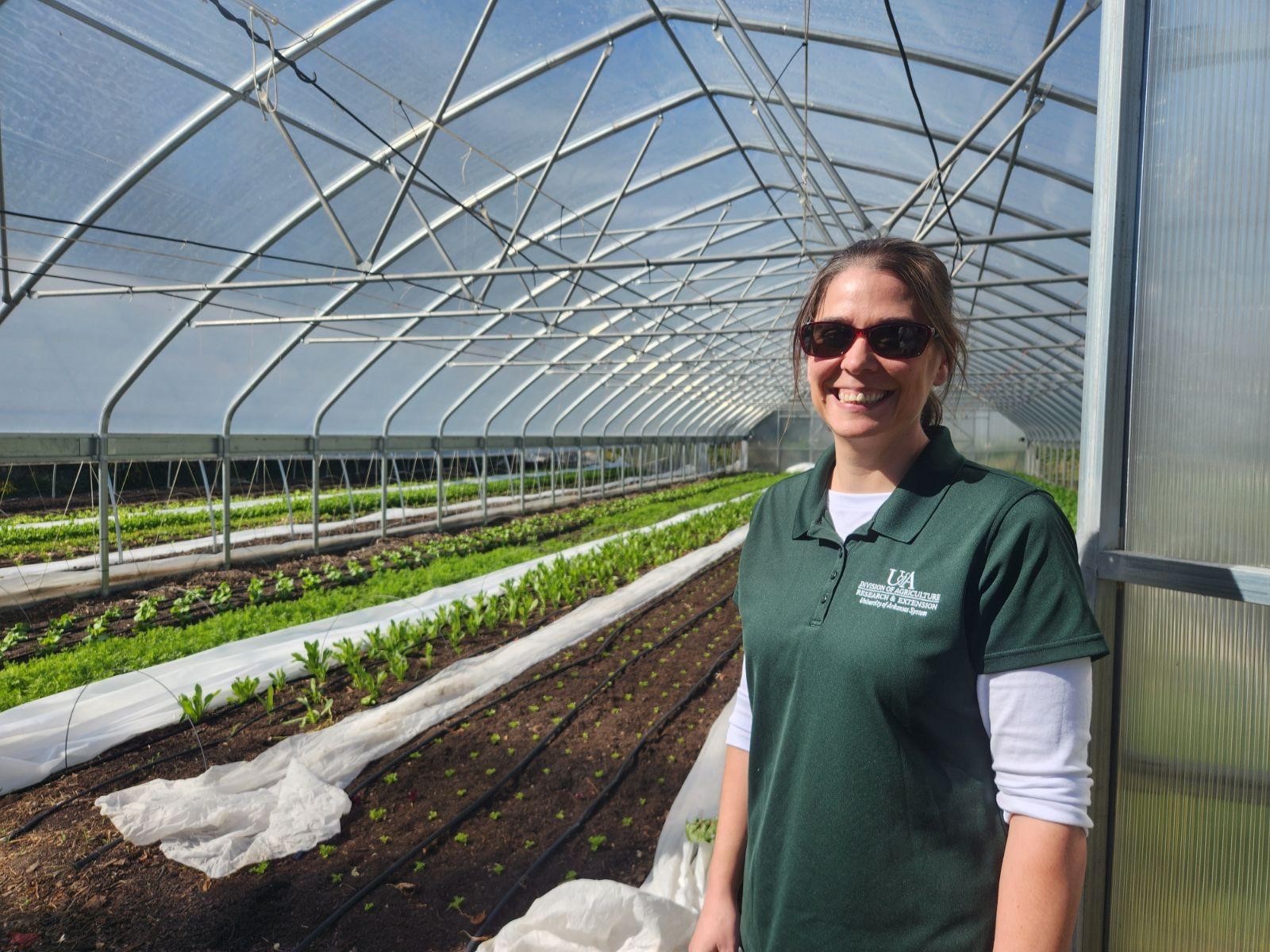Division of Agriculture invests in high tunnel research, resources
Nov. 2, 2023
By Sarah Cato
U of A System Division of Agriculture
Fast Facts:
- Taunya Ernst hired as Division of Agriculture high tunnel and urban agriculture instructor
- Focus will be on the creation of high tunnel resources, one-on-one assistance
- Contact Ernst at 501-671-2033 or ternst@uada.edu
(566 words)
(Newsrooms: Download photos of Ernst)

LITTLE ROCK – Utah native Taunya Ernst is using her multi-state experience with high tunnels to help Arkansas producers adjust a traditionally cold-climate tool for warmer areas as the new high tunnel and urban agriculture instructor for the University of Arkansas System Division of Agriculture.
Although high tunnels are typically used in colder climates to extend growing seasons, growers in Arkansas and across the Southeast have adopted them for shade and weather. However, because high tunnels are relatively new to warmer climates, there is a shortage of resources for high tunnel usage in the Mid-South.
This lack of resources became more apparent as Arkansas growers increasingly took advantage of the Natural Resources Conservation Service high tunnel cost-share program.
Because all existing research and resources for high tunnels have focused on colder climates, many of the high tunnels acquired were being used incorrectly for Arkansas temperatures. As a result, Ernst’s extension instructor position was created through a Natural Resources Conservation Service Technical Assistance Grant to Division of Agriculture’s Amanda McWhirt, horticulture production specialist, and Aaron Cato, horticulture integrated pest management specialist.
“We are excited to have a position dedicated to supporting growers statewide with technical assistance on high tunnels, particularly as the number of high tunnels increases in Arkansas,” McWhirt said. “Taunya has vast experience growing multiple annual and perennial crops in high tunnels, developing extension materials and she brings a unique expertise due to her work for a commercial indoor-farming company.”
“Although many growers in Arkansas and the Southeast are getting financial assistance for these high tunnels, the only resources they have to help with production and purchasing decisions are catering to colder-climate areas,” Ernst said. “Because of this, a lot of high tunnels acquired are either used incorrectly or not at all.”
Not all high tunnels are the same
Perhaps the best example of this is Ernst’s first experience with a high tunnel in Arkansas. In her first position with the Division of Agriculture as a program associate for the Fruit Research Station, Ernst was excited to see the station using a high tunnel.
“In northern Utah I had worked with several different types of high tunnels and when I saw the Fruit Research Station had one, I thought, ‘Oh, I know what I’m doing here!’” Ernst said. “But we ended up having such a hard time cooling it down that we had to actually cut the plastic sides of the tunnel just so our tomatoes could grow. It was very eye-opening to see that not all high tunnels are the same.”
To help growers with purchasing and production decisions, the main focus of Ernst’s new role is to create a high tunnel production guide specifically for warmer climates. Additionally, Ernst will be hosting field days and working one-on-one with growers that need assistance.
“Arkansas has a variety of very different climates, so it’s important that these field days are accessible to and applicable to growers statewide,” Ernst said. “I’m very excited to work with our state’s growers and county extension agents to get their input and tailor these field days for every corner of the state.”
Ernst said she’s excited to come back to the Division of Agriculture and looks forward to getting to know the state’s growers and help with their high tunnel production systems. She encourages any producer, big or small, looking for high tunnel assistance to contact her at ternst@uada.edu or 501-671-2033.
To learn about extension programs in Arkansas, contact your local Cooperative Extension Service agent or visit www.uaex.uada.edu. Follow us on X and Instagram at @AR_Extension. To learn more about Division of Agriculture research, visit the Arkansas Agricultural Experiment Station website: https://aaes.uada.edu. Follow on X at @ArkAgResearch. To learn more about the Division of Agriculture, visit https://uada.edu/. Follow us on X at @AgInArk.
About the Division of Agriculture
The University of Arkansas System Division of Agriculture’s mission is to strengthen agriculture, communities, and families by connecting trusted research to the adoption of best practices. Through the Agricultural Experiment Station and the Cooperative Extension Service, the Division of Agriculture conducts research and extension work within the nation’s historic land grant education system.
The Division of Agriculture is one of 20 entities within the University of Arkansas System. It has offices in all 75 counties in Arkansas and faculty on five system campuses.
Pursuant to 7 CFR § 15.3, the University of Arkansas System Division of Agriculture offers all its Extension and Research programs and services (including employment) without regard to race, color, sex, national origin, religion, age, disability, marital or veteran status, genetic information, sexual preference, pregnancy or any other legally protected status, and is an equal opportunity institution.
# # #
Media Contact:
Sarah Cato
scato@uada.edu
870-815-9035